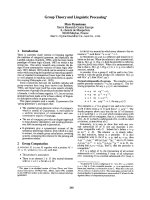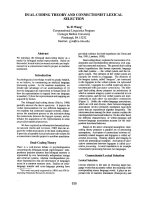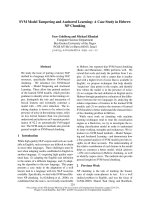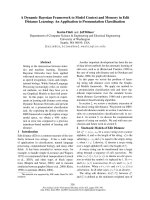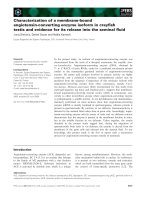Báo cáo đề tài Mô hình định giá tài sản vốn The Capital Asset Pricing Model: Theory and Evidence
Bạn đang xem bản rút gọn của tài liệu. Xem và tải ngay bản đầy đủ của tài liệu tại đây (2.5 MB, 30 trang )
L/O/G/O
The Capital Asset Pricing Model:
Theory and Evidence
Eugene F. Fama and Kenneth R. French
(summer 2004)
The Capital Asset Pricing Model:
Theory and Evidence
Eugene F. Fama and Kenneth R. French
(summer 2004)
Members:
1. Trần Văn Hùng
2. Võ Trung Nhân
3. Hồ Thị Đoan Trang
4. Trương Ngọc Quỳnh Trang
ABSTRACT
ABSTRACT
The attraction of the CAPM is that it offers powerful and intuitively pleasing
predictions about how to measure risk and the relation between expected
return and risk. Unfortunately, the empirical record of the model is poor—poor
enough to invalidate the way it is used in applications.
Contents
Contents
1
2
3
The Logic of the CAPM
Early Empirical Tests
Alternative models
7
1
The Logic of the CAPM
The Logic of the CAPM
Investors choose “mean-
variance-efficient” portfolios.
minimize the variance of portfolio return, given
expected return
maximize expected
return, given variance
Markowitz’s model
The model assumes investors are risk averse
and, when choosing among portfolios, they care
only about the mean and variance of their one-
period investment return.
•
Investors agree on the joint distribution of asset returns from t – 1 to t.
•
And this distribution is the true one.
complete
agreement
there is borrowing and lending at a risk-free rate, which is the
same for all investors and does not depend on the amount
borrowed or lent
risk-free rate
The Logic of the CAPM
The Logic of the CAPM
Sharpe (1964) and Lintner (1965) add two key assumptions
The Logic of the CAPM
The Logic of the CAPM
E(Ri) = RF +
[E(RM) – RF] βiM
Market portfolio M must be on the minimum
variance frontier
The Logic of the CAPM
The Logic of the CAPM
Fischer Black (1972)
Fischer Black (1972)
Unrestricted risk-free borrowing and lending is an
unrealistic assumption
The market portfolio is efficient, which means that the
minimum variance condition for M given above holds
E(RZM) must be less than the expected market return, premium for beta is positive
allowing unrestricted short sales of risky assets
The assumption that short selling is unrestricted
is unrealistic
Jensen (1968)
Blume (1970), Friend & Blume (1970)
and Black, Jensen & Scholes (1972)
Merton 1973
)
Basu (1977)
Banz (1981)
Early Empirical Tests
Early Empirical Tests
Gibbons, Ross & Shanken (1989)
Fama and MacBeth (1973)
Statman (1980), Rosenberg, Reid
& Lanstein (1985)
Friend & Blume (1970), Black, Jensen
& Scholes (1972), Stambaugh (1982)
Fama and French (1992, 1993)…
Beta premium is positive
Assets uncorrelated with the market have expected returns equal to the risk-free interest rate,
and the beta premium is the expected market return minus the risk-free rate
Expected returns on all assets are linearly related to their betas, and no
other variable has marginal explanatory power
Tests of the CAPM are based on
three implications
Early Empirical Tests
Early Empirical Tests
Tests on Risk Premiums
Tests on Risk Premiums
French and Blume (1970) and Black, Jensen
and Scholes (1972) work with portfolios,
rather than individual securities to reduces
the critical errors in variables problem
The regression residuals
Estimates of beta for individual assets are
imprecise
Fama and MacBeth (1973) propose a
method for addressing the inference
problem caused by correlation of the
residuals in cross-section regressions
Fama-Macbeth 1973
Fama-Macbeth 1973
Tests on Risk Premiums
Tests on Risk Premiums
Douglas (1968), Black, Jensen and Scholes (1972),
Miller and Scholes (1972), Blume and Friend (1973),
Fama and MacBeth (1973)
Douglas (1968), Black, Jensen and Scholes (1972),
Miller and Scholes (1972), Blume and Friend (1973),
Fama and MacBeth (1973)
The intercept is greater than the average risk-free
rate and the coefficient on beta is less than the
average excess market return
The evidence show that the relation between beta
and average return is too flat
Friend and Blume (1970), Black, Jensen and
Scholes (1972) and Stambaugh (1982)
Friend and Blume (1970), Black, Jensen and
Scholes (1972) and Stambaugh (1982)
The intercepts in time-series regressions of excess asset
returns on the excess market return are positive for assets
with low betas and negative for assets with high betas
Blume (1970), Friend &Blume (1970)
and Black, Jensen &Scholes (1972)
Blume (1970), Friend &Blume (1970)
and Black, Jensen &Scholes (1972)
Fischer Black (1972)
Fischer Black (1972)
Fama-Macbeth 1973
Fama-Macbeth 1973
Blume (1970), Friend &Blume (1970)
and Black, Jensen &Scholes (1972)
Blume (1970), Friend &Blume (1970)
and Black, Jensen &Scholes (1972)
Bhandari (1988)
Banz (1981)
Basu (1977)
when common stocks are sorted on earnings-price ratios, future returns on high E/P
stocks are higher than predicted by the CAPM.
high debt-equity ratios are associated with returns that are too high
relative to their market betas
a size effect: when stocks are sorted on market capitalization, average returns on
small stocks are higher than predicted by the CAPM
Statman (1980) and
Rosenberg, Reid and Lanstein
(1985)
stocks with high book-to-market equity ratios have high average
returns that are not captured by their betas
Basu
(1977)
Fama and French
(1992)
size, E/P, D/E and B/M ratios add to the explanation of expected
stock returns provided by market beta
Merton 1973 - ICAPM
Merton 1973 - ICAPM
the market portfolio is multifactor efficient but
it requires additional betas, along with a market
beta, to explain expected returns
ICAPM investors consider how their wealth at t might
vary with future state variables, including labor income,
the prices of consumption goods and the nature of
portfolio opportunities at t, and expectations about above
factors
ICAPM
ICAPM investors prefer high expected return and
low return variance. But ICAPM investors are also
concerned with the covariances of portfolio returns
with state variables
Chen-Roll-Ross 1986
Chen-Roll-Ross 1986
Three-factor model
Fama and French (1993, 1996)
Three-factor model
Fama and French (1993, 1996)
SMBt is the difference between the returns on diversified
portfolios of small and big stocks
HMLt is the difference between the returns on diversified portfolios of high and low
B/M stocks
Carhart 1997
Carhart 1997
Early Empirical Tests
Early Empirical Tests
Their view is based on evidence that stocks with high ratios of book value to market price are typically firms that have fallen on
bad times, while low B/M is associated with growthfirms (Lakonishok, Shleifer and Vishny, 1994; Fama and French, 1995). The
behavioralists argue that sortingfirms on book-to-market ratios exposes investor overreaction to good and bad times. Investors
overextrapolate past performance, resulting in stock prices that are too high for growth (low B/M) firms and too low for distressed
(high B/M, so-called value)firms.
Their view is based on evidence that stocks with high ratios of book value to market price are typically firms that have fallen on
bad times, while low B/M is associated with growthfirms (Lakonishok, Shleifer and Vishny, 1994; Fama and French, 1995). The
behavioralists argue that sortingfirms on book-to-market ratios exposes investor overreaction to good and bad times. Investors
overextrapolate past performance, resulting in stock prices that are too high for growth (low B/M) firms and too low for distressed
(high B/M, so-called value)firms.
Explanations: Irrational Pricing or Risk
Explanations: Irrational Pricing or Risk
The need for a more complicated asset pricing model. The CAPM is based on many unrealistic assumptions.
The need for a more complicated asset pricing model. The CAPM is based on many unrealistic assumptions.
Tests of the CAPM are
not sensitive to
expanding the market
proxy beyond common
stocks
Stambaugh (1982)
Fama and French (1998)
If international capital
markets are open and asset
prices conform to an
international version of the
CAPM, the market portfolio
should include international
assets.
betas for a global stock
market portfolio cannot
explain the high average
returns observed around
the world on stocks with
high BE/ME or high E/P
ratios.
When proxies are used in
tests of the model show up as
bad estimates of expected
returns in applications:
estimates of the cost of equity
capital that are too low for
small stocks and for stocks
with high BE/ME ratios
The Market Proxy Problem
The Market Proxy Problem
Conclusions
Conclusions
The CAPM, like Markowitz’s (1952, 1959) portfolio model on which it is built, is nevertheless a
theoretical tour de force. We continue to teach the CAPM as an introduction to the fundamental
concepts of portfolio theory and asset pricing, to be built on by more complicated models like Merton’s
(1973) ICAPM. But we also warn students that despite its seductive simplicity, the CAPM’s empirical
problems probably invalidate its use in applications.
The CAPM, like Markowitz’s (1952, 1959) portfolio model on which it is built, is nevertheless a
theoretical tour de force. We continue to teach the CAPM as an introduction to the fundamental
concepts of portfolio theory and asset pricing, to be built on by more complicated models like Merton’s
(1973) ICAPM. But we also warn students that despite its seductive simplicity, the CAPM’s empirical
problems probably invalidate its use in applications.


